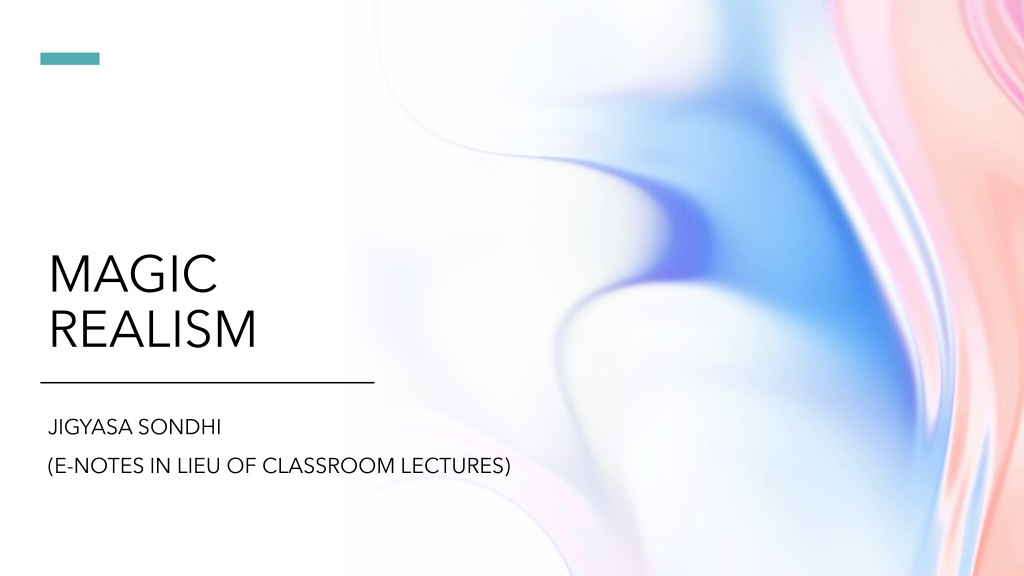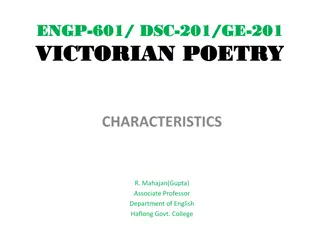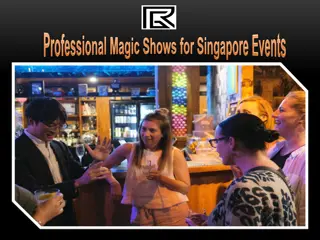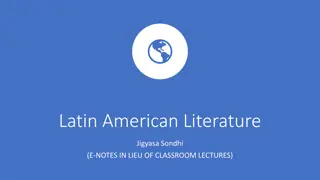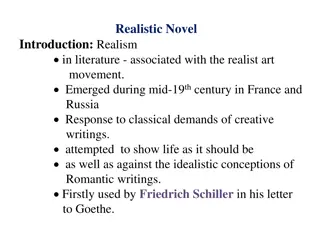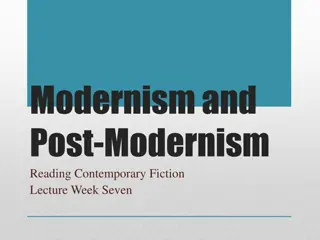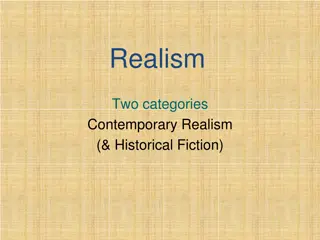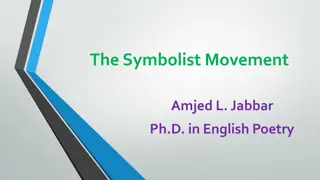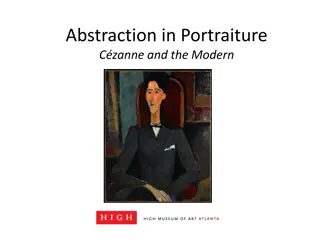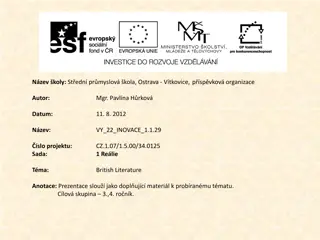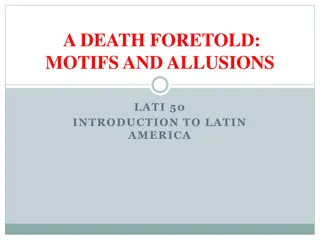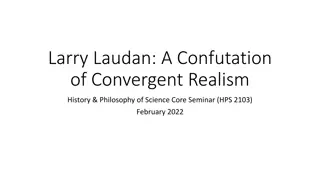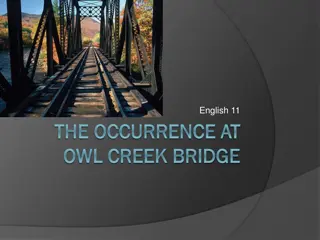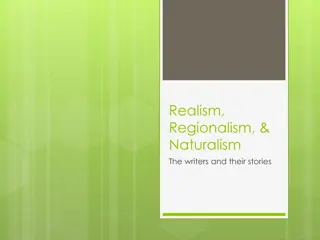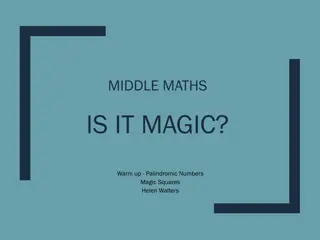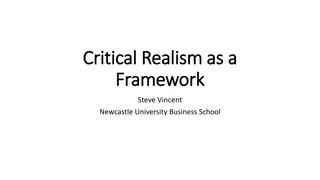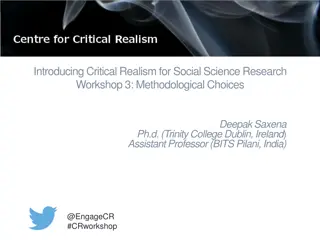Exploring Magic Realism in Literature
Magic Realism is an artistic genre that blends magical elements with realistic settings, intertwining external and internal realities. Popularized by writers like Marquez and Borges, it challenges traditional narrative structures and blurs boundaries between the real and the fantastical. This genre invites readers to decode texts from unique perspectives, often weaving elements of dreams, myths, and cultural imaginings. The novel "Chronicle of a Death Foretold" is a prime example of Magic Realism, featuring warped timelines and enigmatic storytelling elements.
Download Presentation

Please find below an Image/Link to download the presentation.
The content on the website is provided AS IS for your information and personal use only. It may not be sold, licensed, or shared on other websites without obtaining consent from the author. Download presentation by click this link. If you encounter any issues during the download, it is possible that the publisher has removed the file from their server.
E N D
Presentation Transcript
MAGIC REALISM JIGYASA SONDHI (E-NOTES IN LIEU OF CLASSROOM LECTURES)
MR is an artistic genre in which magical elements appear in a realistic setting. Term MR was first used by German art critic Franz Roh to describe a painting which demonstrated an altered reality. In lit, MR often combines external factors of human existence with internal ones: It is a fusion between scientific physical reality & psychological human reality. Incorporates aspects of human existence such as thoughts, emotions, dreams, cultural mythologies & imaginations.
MH Abrams Term originally applied in the 1920s to a school of painters, is used to describe the prose fiction of Jorge Luis Borges in Argentina, as well as the work of writers such as Ma rquez in Colombia, Gunter Grass in Germany, and John Fowles in England. These writers interweave, in an ever-shifting pattern, a sharply etched realism in representing ordinary events and descriptive details together with fantastic and dreamlike elements, as well as with materials derived from myth and fairy tales. These novels violate, in various ways, standard novelistic expectations by drastic - and sometimes highly effective - experiments with subject matter, form, style, temporal sequence, and fusions of the everyday, the fantastic, the mythical, and the nightmarish, in renderings that blur traditional distinctions between what is serious or trivial, horrible or ludicrous, tragic or comic.
Six features that can be found in all MR texts: 1. Perspective is that of the other 2. Duties of readers in decoding texts have evolved 3. Setting has a relatively specific, historical, geographical, cultural context 4. Reality presented as human experience of universe and elements such as dreams & imaginations are consequently present 5. Free, post-structuralist style of writing 6. The inexplicable in its shapes and forms plays a major role in all MR texts.
Although MR lit varies in its structure & presentation, one universal theme is the use of the fantastical to highlight & challenge the setting s paradigm, rather than merely as a plot device or setting MR often considered as a sub-category of post-modern fiction due to its use of techniques similar to those other post-modernists such as the distortion of time Like many Latin American writers, GGM has been linked to MR lit. The lit of this type is usually characterised by elements of the fantastic woven into the story with a dead-pan sense of presentation.
The novel Chronicle of a Death Foretold exhibits many aspects written in MR style. For instance, novel makes oblique reference to God. Additionally, it has the MR aspects of a warped timeline: 1. Main plot plays five times, once in each of the five chapters. While this is reminiscent of traditional tragic format, it turns it inside out. 2. Narrator s inclusion of personal judgements as well as events occurring many years after the drama unfolds, seems to breach the definition of a chronicle. 3. Kaleidoscopic imagery found in novel adds to this impression and combined with the contorted chronological structure and the town people s anticipation of Santiago s murder erodes plausibility of mere irresponsibility as an explanation for the tragedy. (cont. )
4. Incongruities fit in with the MR style: it may be put down to fate. 5. Opposite of unlikely powerlessness, unlikely endurance, is also present as Santiago s stench permeates the town even after he dies. Subtle intersection of human values and supernatural with the physical world is a hallmark of MR
Salman Rushdie, an Anglo-Indian novelist, whose style is often classified under MR, has principally used MR in his famous Midnight s Children. Novel involves telepathic abilities of Saleem and the other thousand and one children born at the stroke of midnight on August 15, 1947 (date of Indian Independence) Abilities that enable them to communicate with each other and in Saleem s case, to read the minds of those around him.
MR has a positive impact Is a protest against the injustices, but is also a way of life, and that too, an optimistic one. MR helps to look at reality from a different perspective It is the way in which we would like to interpret the reality, but which might not be possible in the sphere of practical life.
